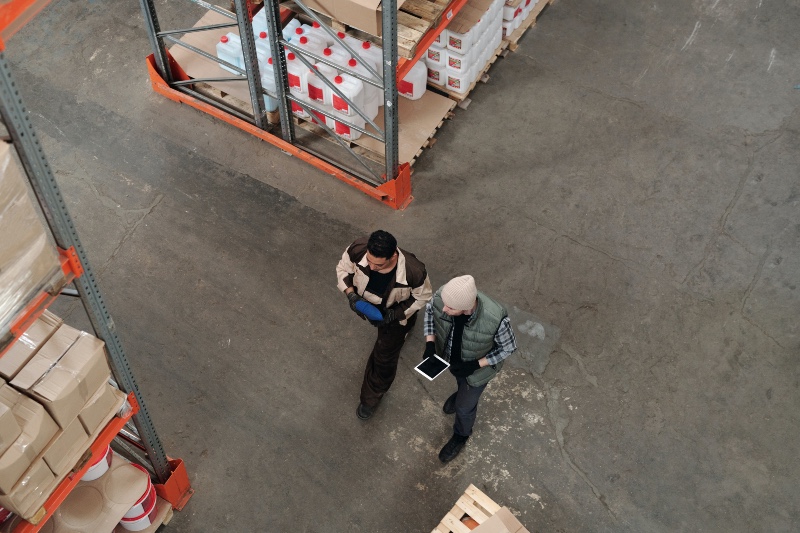
Embracing Warehouse Automation
Warehouse automation is becoming an essential part of modern supply chain management. As companies strive to meet ever-increasing customer demands, streamline their operations, and reduce costs, they are turning to innovative technologies to revolutionize their warehousing processes. In this article, we will explore the various types of warehouse automation technologies, discuss their benefits and potential challenges, and look at the future of warehouse automation in supply chain management.
Exploring Warehouse Automation Technologies
1. Robotics: Robotics technology has advanced rapidly in recent years, allowing companies to automate repetitive tasks such as picking, packing, and palletizing. Robotic solutions include autonomous mobile robots (AMRs), automated guided vehicles (AGVs), and robotic arms. To learn more about how robotics are transforming warehouse automation, check out this article on the Rise of the Warehouse Robots – LogisticsIQ.
2. Automated Storage and Retrieval Systems (AS/RS): AS/RS technology streamlines the storage and retrieval of goods within a warehouse. These systems use vertical space efficiently and can dramatically increase warehouse capacity.
3. Warehouse Management Systems (WMS): WMS software is essential for managing and optimizing warehouse operations, from tracking inventory levels to coordinating staff and equipment.
4. Internet of Things (IoT) Devices: IoT devices, such as sensors and RFID tags, can track inventory in real-time, allowing for improved visibility and more accurate demand forecasting.
5. Artificial Intelligence (AI) and Machine Learning: AI and machine learning can be used to analyze data and improve warehouse processes, such as optimizing picking routes and predicting equipment maintenance needs.
The Advantages of Warehouse Automation
Efficiency: Automated systems can perform tasks more quickly and accurately than humans, reducing the time it takes to process orders and increasing overall productivity.
Cost Savings: By reducing labor costs and improving efficiency, warehouse automation can result in significant cost savings for businesses.
Enhanced Accuracy: Automation technologies can help to minimize errors in tasks such as picking and packing, leading to fewer returns and increased customer satisfaction.
Improved Safety: Automated systems can take over dangerous or repetitive tasks, reducing the risk of workplace injuries.
Scalability: Warehouse automation solutions can be easily scaled up or down as needed, making it easier for businesses to adapt to changes in demand.
Overcoming Challenges in Warehouse Automation
High Initial Investment: Implementing warehouse automation technologies can be expensive, particularly for small and medium-sized businesses.
Technical Complexity: As with any advanced technology, warehouse automation systems can be complex to set up, maintain, and troubleshoot.
Workforce Impact: Automation can lead to job displacement, requiring businesses to retrain or redeploy affected workers.
The Role of Warehouse Automation in Future Supply Chains
As technology continues to advance, warehouse automation is set to play an increasingly important role in supply chain management. Companies that embrace these technologies will be better positioned to meet customer demands, streamline their operations, and stay competitive in the rapidly evolving world of logistics. For more insights into supply chain planning and management, check out our articles on How to Choose the Right Inventory Management System and Demand Planning in Supply Chain Management.
Seamless Integration of Technologies
In the coming years, we can expect to see a greater integration of warehouse automation technologies, creating a fully connected and optimized supply chain. This integration will enable better coordination between different systems, such as robotics, AS/RS, and WMS, resulting in a more efficient and streamlined workflow.
Innovations on the Horizon
Emerging technologies, such as drone-based delivery and augmented reality (AR) wearables, will also play a role in the future of warehouse automation. Drones can assist in tasks such as inventory management and order fulfillment, while AR wearables can help warehouse workers quickly locate items and reduce errors.
Prioritizing Sustainability in Warehouse Automation
As businesses become more conscious of their environmental impact, the implementation of sustainable practices in warehouse automation will become a priority. This may include the use of energy-efficient systems, green materials for packaging, and even the integration of renewable energy sources, such as solar panels, to power warehouse operations. For more information on the benefits of implementing sustainable practices in warehousing, read this article about Supply Chain Sustainability is Here to Stay.
Tailoring Automation Solutions to Business Needs
As warehouse automation technologies continue to evolve, we can expect to see a growing demand for customized automation solutions. These tailored systems will cater to the specific needs and challenges of individual businesses, ensuring that they can maximize the benefits of warehouse automation while minimizing potential drawbacks.
Fostering Collaboration for Technological Advancements
In order to drive innovation and stay competitive, companies may increasingly turn to strategic partnerships and collaborations with technology providers, research institutions, and even competitors. These collaborations can help to accelerate the development and implementation of new warehouse automation technologies, ensuring that businesses remain at the cutting edge of supply chain management.
Warehouse Automation: A Key to Supply Chain Success
Warehouse automation is undoubtedly shaping the future of supply chain management. By embracing the technological revolution in warehousing, businesses can improve efficiency, reduce costs, and stay ahead of the competition. It is important for businesses to be proactive in adopting these technologies and to seek out strategic partnerships that can help them navigate the complex landscape of warehouse automation.
As the world continues to change and evolve, those who are prepared to embrace warehouse automation and its potential benefits will be well-positioned to thrive in the increasingly competitive landscape of supply chain management.
Geef een reactie